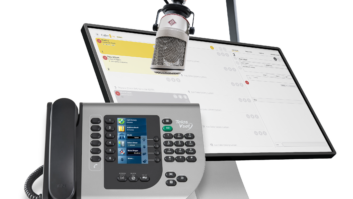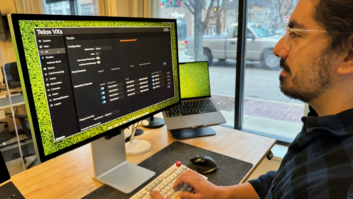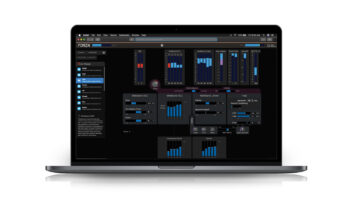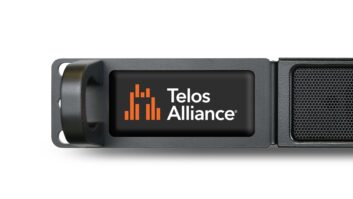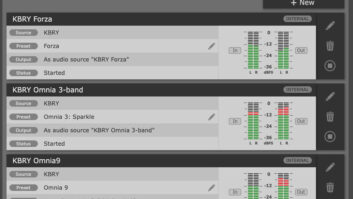“Our old telephone hybrid just works fine, so what’s the problem?”

Christopher Springmann drives his rig. The Telos Hx2 is in the rack above the mixer. Photo by John McDermott. No problem, just replace it, because your callers, reporters and engineers plus the unrelenting world of technology demand that you do, as today’s telephone device-of-choice is very un-POTS and often powered by Apple or Google, not AT&T.
Laura Mir, Radio World contributor and broadcast engineer, persuaded me to acquire a Telos Hx digital telephone hybrid interface with her review of the Hx1(Radio World, March 8, 2011) gushing that: “users will appreciate a bright, intelligible audio quality … compared to existing digital hybrids, this enhancement was immediately noticeable … caller(s) also reported better-than-average return program audio clarity.”
Sold!
But wait, there’s more!My “Life, Love & Health” team now considers the larger Telos Hx2 dual-hybrid perfect for our small “talk show.” Unlike our old single-line Telos One, the Hx2 features an LED “status symbol” display for incoming calls, which makes life much easier for a single operator.Quite honestly, we generally do call-outs for interviews, but the call-in option is invaluable. Conferencing two callers together on the Hx2, often with a guest in studio and/or from a remote NPR studio via ISDN, has given us a “bigger sound.” We’ve added live talk show excitement as we bounce around the country, as in, “Now joining us from her home in Atlanta, Dr. Susan Glutz, a plastic surgeon; and from Houston, her patient, Carole …”
Our tabletop installation features a Mackie Onyx 1220i FireWire mixer that slides nicely under an open On-Stage Stands tabletop rack stand, leaving the faders exposed, while effectively managing cables, too, a bonus. A Pro Tools workstation records the tracks via FireWire, although we always run a backup into an Edirol R-44 four-track SD card recorder, just in case.
But I wondered, how do other Telos Hx users gain value from their units? Was our experience and use typical? And was there something we could learn from them?

So, I spoke to several broadcast engineers, “ops” professionals and independent producers about their acquisition of the Telos Hx1 and 2 digital telephone hybrid interfaces. Their reasons are as varied as their markets and broadcast/netcast mediums; however, there were several recurring themes on why they made the decisions that they did.
Most noted that there was a big quality improvement in cellphone call processing plus excellent handling of POTS calls.
Secondly, there was the ease of operation of the Hx units which allowed them to be deployed into the field, at reporters’ desks and at remote bureaus without the need of having an engineer nearby or extensive training. That fed another element — an attractive price point for single and multiple purchases. As you know, “price point” is a familiar phrase in radio.
Finally, though it wasn’t applicable in our situation — compatibility with existing Telos hybrid wiring and control connections, i.e. Axia Livewire.
Interestingly, most users took for granted the Hx’s gate and limiter feature, AGC and dynamic EQ processor, and ducking feature, preferring to stay with factory settings. Rack it, cable it and get to work.
Telos is currently shipping about 100 Hx1 and Hx2 hybrids every month, more than 3,000 units in two years, according Kirk Harnack, vice president of Telos Products, who supplied me with the names of the Hx1 and Hx2 users I interviewed.
Lazy phoners
Stephen Colón knows all about “lazy phoners” — reporters who tie up valuable production staff time with requests to initiate telephone interview calls, record both sides of the conversation, then download the file to the server for access.
That frustrating, recurring problem became a win-win opportunity for the technical director of American Public Media’s “Marketplace,” as he persuaded management to purchase 15 Telos Hx1 digital hybrids.

“We needed to make a change in the way we managed our reporters around our facilities and around the world and, with an increase of reporters, we needed to find a reliable system that will work really well for everyone,” said Colón. That meant replacing aging Telos One units and a mash-up of consumer grade hybrids with the Telos Hx1.
Colón’s buying decision was also driven by the fact that Hx1 hybrids were designed to handle cellphone calls, POTS lines, plus VoIP. That was good news considering that mobile devices have essentially replaced landlines for on-the-go reporters and callers, too. Reporters now record interviews on their laptops, edit with Adobe Audition and send the results to the “Marketplace” content management server.
The bottom line for Colón? “The reporters are happy, more autonomous and responsive with their own Hx1 unit plugged into a laptop at their work desk or home,” said Colón. “The learning curve was minimal, which meant fewer tech calls for me. And the Hx1 is simple, with three buttons: answer a call or connect after dialing; caller on hold; and drop. It’s simple and quick. Much better than the Telos One.”
Gibson Prichard of NewsChannel5 WTVF(TV) in Nashville, saw the Telos Hx2, the dual-hybrid version, as a solution to an increasingly common challenge. Prichard, WTVF’s chief engineer and chief technology officer, said that “We use the Hx2 for reporter phoners, in cases where we can’t get a microwave or satellite live shot for interviews.”
And when might that be? “In case of severe weather or a natural disaster, we need to hook up with emergency management personnel in the field, and need all the options we can get. The Hx2 is tied to the station’s PBX, which will transfer the two-lines to appropriate staff or talent,” he added.
The Telos Hx2 replaced a Gentner single-line digital hybrid which has since been drafted into service for a voice-over booth, servicing reporter’s interview phoners.
“The Hx2 call quality is noticeably improved over the Gentner,” observed Prichard, “particularly when the call originates on a mobile phone, as is often the case. Also, the AES output option fit nicely with our Harrison TVDSL-9632 multichannel TV audio console. The Hx2 is mounted in a rack just an arm’s length of the audio operator.”
Handling cellphone and POTS calls well, especially in emergency situations, was also a priority for Jeff Batten’s acquisition of the dual-hybrid Hx2. Jeff is senior engineer for Clear Channel in Nashville, where he oversees five stations plus the Tennessee Radio Network. Now in his 40th season (“or about 107 ‘dog years,’ same as ‘radio years!’” he joked), Jeff always has an old school POTS phone handy, “so just in case the cell tower falls down, I can get a dial tone.”
Batten acquired an Hx2 for Nashville’s WLAC(AM) to replace a Telos 100 Delta hybrid, primarily for the Hx’s superior handling of mobile calls. And much like WTVF’s Gibson Prichard, Batten is concerned about having multiple communication pathways in emergency situations. “The way we’re set up, if somebody had to go into the control room to record one of our weather guys, the [talent] could call in on one of the [Hx2] lines and the board op could bring in the local fire chief on the second line.” Batten is also anticipating short-staffing problems, too. “Like, say we’ve got floods and there’s only one guy in the building right now — he could actually host the show in the control room with the Hx2.”
Pocket HX?
Steve Johnston, director of engineering and operations at Wisconsin Public Radio, racked his new Hx2 at a WPR bureau to provide two guest lines for talk shows, replacing a Telos One+One, while the listener-callers are handled by the larger multiline Telos One-x-Six.
“I don’t consider it [the Hx2] enough for a talkshow but we use it to support the other unit,” said Johnston, as he sat at the WPR console equipped with an Audioarts R-55e with three Superphone modules. A fixed mixer under the cabinetry handles the cross-connected mix-minuses for the caller output from the Telos One-x-Six and the two guest outputs from the Telos Hx2.
Colón of “Marketplace,” who probably oversees more Telos Hx hybrid units than any engineer in America, has a short wish list for the unit: a backpack or briefcase-sized version for location work, typically at home, a hotel or airport.
I ran that request by Telos’ Harnack who, not surprisingly, would love to add such a unit to the line. According to Harnack, the challenges are daunting “… as there’s no universal standard for digital phone systems typically found in hotel rooms. Designing a hybrid connection to work with all or most of them would be like designing a transmission that works in any car on the road,” he added.
But Telos is working toward more solutions for IP-connected codecs, which Harnack describes as the future for remote interviews, sports and other on-location reporting. “Such IP codecs can be wired to the Internet or wireless via Wi-Fi or 3G/4G data modems. There are applications coming out for smartphones that allow a reasonably high-quality audio connection via IP codecs back to a studio, for example,” Harnack offered.
I’m sure Stephen Colón will stay tuned.
Christopher Springmann is the producer of the syndicate “Life, Love & Health” health talk show.
Any tips or techniques you’ve learned and would like to share with the RW community? We’d like to include you in RW’s Letters-to-the-Editor and a future article.Email us at [email protected].





